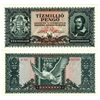1945 Hungary 10,000,000 (10 Million) Pengő P-123 Hyperinflation Banknote NEW CRISP UNCIRCULATED VERY RARE IN THIS CONDITION
The 10,000,000 Pengő banknote is a remarkable piece of Hungarian monetary history, issued in 1945 during a period of extreme hyperinflation, one of the most severe instances of currency devaluation in history. This banknote represents the Hungarian government's desperate attempts to keep up with the rapidly decreasing value of their currency.
Design and Features:
The design of the 10,000,000 Pengő banknote reflects the era's aesthetic and technological capabilities, featuring intricate patterns and motifs that were common in currency design of the time. The banknote typically showcases a blend of architectural and national symbols, aimed at instilling a sense of patriotism and stability amidst economic chaos. The colors and printing techniques used were advanced for the period, yet the rapid devaluation meant that these notes were often quickly replaced by even higher denominations. THESE ARE CRISP NEW UNCIRCULATED PENGO BANKNOTES. EXTREMELY HARD TO FIND UNCIRCULATED
Historical Significance:
This banknote is a tangible reminder of the catastrophic impact of hyperinflation on an economy and a society. Hungary's post-World War II hyperinflation reached its peak in 1945, leading to the issuance of such high denominations. The period was marked by economic instability, with prices doubling every 15.6 hours at its worst. The 10,000,000 Pengő banknote embodies the government's struggle to maintain a semblance of normalcy in the face of economic collapse.
Collector's Value:
For collectors, the 10,000,000 Pengő banknote is highly sought after due to its historical significance and the story it tells of hyperinflation's extreme effects. Its value to collectors lies not just in its rarity or condition but in its ability to convey a profound economic and historical lesson. As such, it holds both monetary and educational value, making it a prized piece in collections focused on hyperinflationary currencies or 20th-century European history.

















